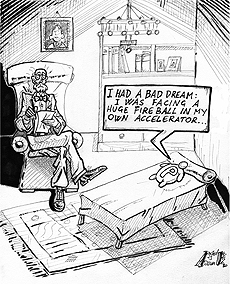Lead bottom
 |
| Today's article describes what happens when you collide individual protons into lead nuclei. This result helps understand an exciting new state of matter called a quark gluon plasma. Image: CERN |
The nice thing about the LHC research program is that it allows scientists to investigate many phenomena. All are exotic, with some pushing the very frontier of knowledge, while some investigate complex phenomena as a means to understand even more complex phenomena.
When two heavy atomic nuclei are slammed together at very high energy, a peculiar thing occurs. The temperatures in these collisions are so high that the protons and neutrons in the nuclei literally melt, and the quarks and gluons that are normally inside the protons and neutrons can move around freely. We call this state of matter a quark-gluon plasma.
In addition, the high collision energy can convert into matter-antimatter pairs, as suggested by Einstein's equation E=mc2. If you want to study what occurs in the collision, you look for types of matter that don't exist as ordinary matter. One example of this more exotic type of matter is bottom quarks. Since they don't generally exist inside the nuclei of atoms, if you see bottom quarks, you know that they were made from the energy of the collision.
Scientists have lots of experience making bottom quarks by colliding two protons together. This is the way we run the LHC for most of the time, and we have made (although not recorded) many billions of bottom quarks. The process is pretty well-understood.
We also can make bottom quarks by colliding two lead nuclei together. We do this at the LHC about one month per year. In these collisions, a total of 416 protons and neutrons are smashed together. Naively, you'd expect that all the protons and neutrons can participate in the collision and that the number of bottom quarks that are made can be easily calculated from the well-understood proton-proton scattering process.
However, we see fewer bottom quarks than we'd expect from lead-lead collisions. The usual explanation is that these bottom quarks have to push their way through the hot quark-gluon plasma. They become tired and slow down, so they don't escape the collision.
But there might be other explanations. Maybe the fact that the colliding protons and neutrons are bound in nuclei (rather that floating freely) influences how their component quarks and gluons are distributed inside them.
To work out this ambiguity, CMS scientists decided to smash together a beam of protons into a beam of lead nuclei. If the lower-than-expected number of bottom quarks in lead-lead collisions was due to the way bottom quarks plow through quark-gluon plasma you'd expect to see no reduction in the production of bottom quarks from these lead-proton collisions, since the quark-gluon plasma is not made in these kinds of collisions. If the effect was due to the moving around of energy inside nuclei, you'd expect to see behavior midway between the proton-proton and lead-lead scattering.
As it happens, scientists observed no reduction in the production of bottom quarks. This strongly suggests that the reduction seen in collisions between two lead nuclei originates in the bottom quarks trying to punch through the quark gluon plasma. Thus this measurement validates our understanding of the behavior of matter hot enough to melt protons and neutrons.
—Don Lincoln
 |
| These U.S. CMS scientists made important contributions to this analysis. |
|